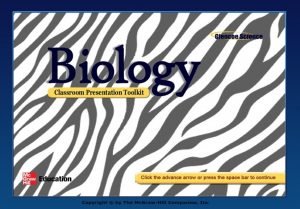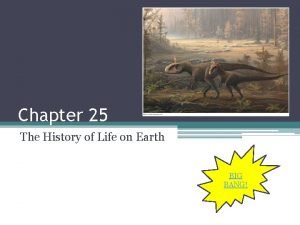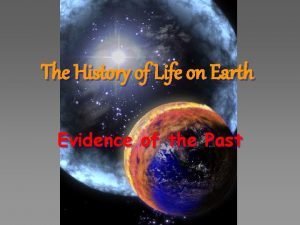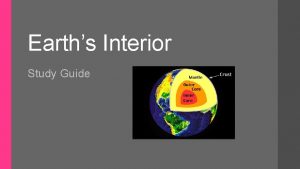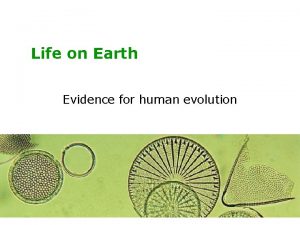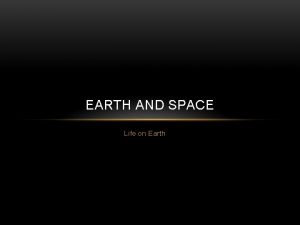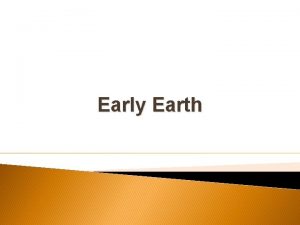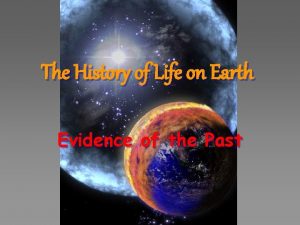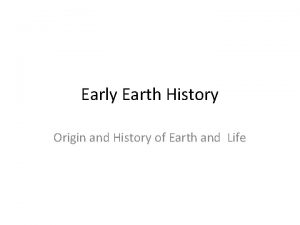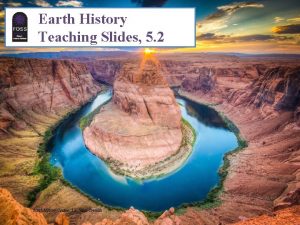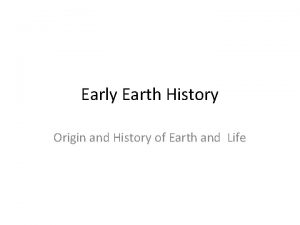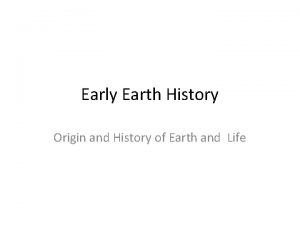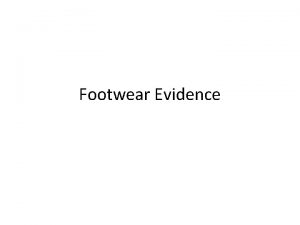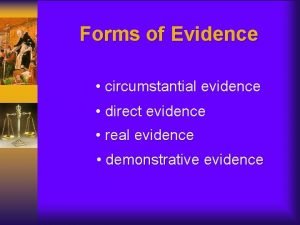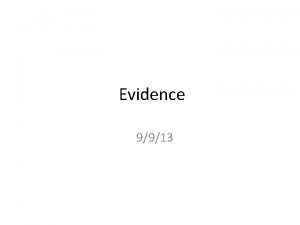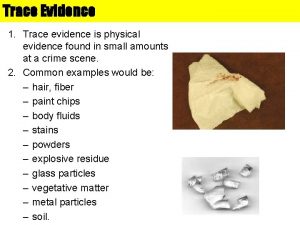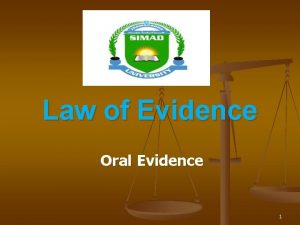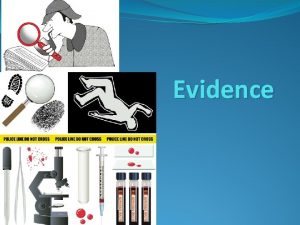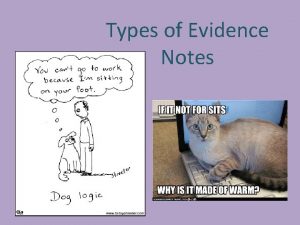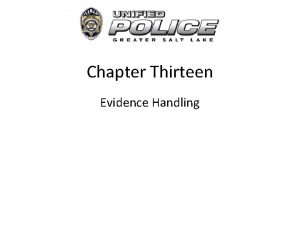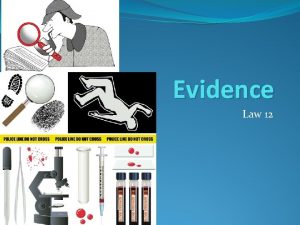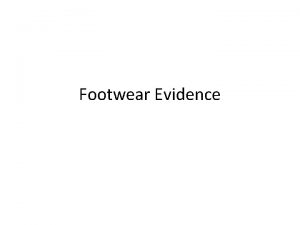The History of Life on Earth Evidence of































- Slides: 31

The History of Life on Earth Evidence of the Past

Fossils: traces or imprints of once-living things l Dead organism is covered by layer of sediment, which presses together to form sedimentary rock l

The Ages of Fossils l Sedimentary rock has layers, with the oldest layers usually on the bottom and newest on the top l Layers where the fossils are found tells a scientist the relative age of fossil l Relative dating: Estimating age of fossil by its position in the rock layers

Relative Dating

Absolute Dating l When scientists want to determine the age of a fossil more precisely, they use absolute dating to get an exact age l Absolute dating: method of measuring age of object in years

l Scientists examine atoms, which over time, decay by releasing energy l The time it takes for half a sample of atoms to decay is its half-life Scientists measure the ratio of stable to unstable atoms to determine the age of a sample of rock l

The Geologic Time Scale l Scientists use a type of calendar to divide the Earth’s long history l Calendar is divided into very long units of time since the Earth formed so long ago l Geologic Time Scale: the standard method used to divide the Earth’s long natural history into manageable parts



Divisions in Geologic Time Scale Divided into eras, which are characterized by the type of organisms that dominated the Earth at that time l Precambrian Time: from formation of Earth 4. 6 billion years ago to about 543 million years ago l l Volcanic eruptions, meteorites, intense radiation from the sun


l l l Early atmosphere had no oxygen—first organisms were prokaryotes (no nucleus) Cyanobacteria appeared produced own food and released oxygen Ozone layer forms in upper atmosphere and absorbs radiation from the sun

l Paleozoic Era: rocks rich in fossils of animals such as sponges, corals, clams, squids, and trilobites l Fishes appeared, sharks more abundant, forests of giant ferns covered earth

Paleozoic Era

l Mesozoic Era: dominated by dinosaurs and other reptiles, referred to as Age of Reptiles l l First birds appeared; flowering plants appeared By end of era, dinosaurs and many other plants and animal species became extinct

l Cenozoic Era: sometimes called “Age of Mammals” l Mammals included mastodons, saber-toothed cats, camels, and giant ground sloths l Included some periods known as ice ages


Mass Extinctions l Some of the important divisions in geologic time scale mark times when rapid changes happened on Earth l During these times, many species died out completely, or became extinct l When a species is extinct, is does not reappear

l Periods when many species suddenly become extinct are called mass extinctions l Most scientists think that the extinction of the dinosaurs happened because of extreme changes in the climate on Earth

l These changes could have resulted from a giant meteorite hitting the earth, or forces within causing major earthquakes and volcanic eruptions

The Changing Earth l Pangaea -German scientist Alfred Wegener noticed that the continents of Earth look like pieces of a puzzle -proposed that long ago the continents formed one landmass surrounded by gigantic ocean

l Wegener called the single landmass “Pangaea” which means “all Earth”

Do the Continents Move? In mid-1960’s, J. Tuzo Wilson came up with idea that continents were not moving by themselves l Wilson thought that huge pieces of Earth’s crust were pushed by forces within the planet l

l Each piece of crust is called a tectonic plate l Wilson’s theory of how the huge pieces of crust move is called plate tectonics

According to Wilson, outer crust of Earth is broken into seven large plates and several smaller ones l Motion of the plates causes continents to move l

Adaptations to Slow Changes When conditions on Earth change, organisms may become extinct l A rapid change, such as a meteorite impact, may cause mass extinction l

l Slow changes, such as moving continents, allow time for adaptation l Everywhere on Earth, living things are well adapted to location where they live l Yet in that location, there is evidence that organisms that lived there in the past were very different




 The history of life section 1 fossil evidence of change
The history of life section 1 fossil evidence of change Chapter 25 the history of life on earth
Chapter 25 the history of life on earth History of life on earth
History of life on earth The history of life on earth
The history of life on earth Primary evidence vs secondary evidence
Primary evidence vs secondary evidence Primary evidence vs secondary evidence
Primary evidence vs secondary evidence Primary evidence vs secondary evidence
Primary evidence vs secondary evidence Primary evidence vs secondary evidence
Primary evidence vs secondary evidence Jobs vancouver
Jobs vancouver How can class evidence have probative value
How can class evidence have probative value Class evidence vs individual evidence
Class evidence vs individual evidence How can class evidence be useful
How can class evidence be useful Class vs individual evidence
Class vs individual evidence Genetic fallacy
Genetic fallacy How do geologists study direct evidence of earth's interior
How do geologists study direct evidence of earth's interior Hát kết hợp bộ gõ cơ thể
Hát kết hợp bộ gõ cơ thể Ng-html
Ng-html Bổ thể
Bổ thể Tỉ lệ cơ thể trẻ em
Tỉ lệ cơ thể trẻ em Voi kéo gỗ như thế nào
Voi kéo gỗ như thế nào Thang điểm glasgow
Thang điểm glasgow Bài hát chúa yêu trần thế alleluia
Bài hát chúa yêu trần thế alleluia Môn thể thao bắt đầu bằng từ chạy
Môn thể thao bắt đầu bằng từ chạy Thế nào là hệ số cao nhất
Thế nào là hệ số cao nhất Các châu lục và đại dương trên thế giới
Các châu lục và đại dương trên thế giới Công thức tính độ biến thiên đông lượng
Công thức tính độ biến thiên đông lượng Trời xanh đây là của chúng ta thể thơ
Trời xanh đây là của chúng ta thể thơ Mật thư anh em như thể tay chân
Mật thư anh em như thể tay chân Làm thế nào để 102-1=99
Làm thế nào để 102-1=99 độ dài liên kết
độ dài liên kết Các châu lục và đại dương trên thế giới
Các châu lục và đại dương trên thế giới Thơ thất ngôn tứ tuyệt đường luật
Thơ thất ngôn tứ tuyệt đường luật
